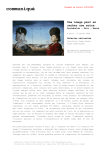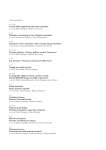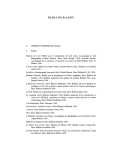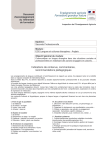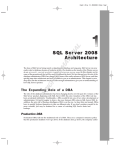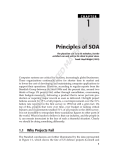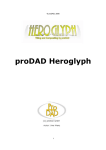Download Theory, theorists and themes: a user's guide to understanding the
Transcript
SEQ 0001 JOB PCP8283-001-008 PAGE-0001 CH1 PP1-22 REVISED 19OCT99 AT 16:23 BY TF DEPTH: 61.02 PICAS WIDTH 44.03 PICAS Chapter 1 Theory, theorists and themes: a user’s guide to understanding the present Gary Browning, Abigail Halcli and Frank Webster Consider the student of Social Sciences and the Humanities in higher education today. He or she will most likely be signed up to study a named discipline such as History, English or Anthropology. A good number will be combining a couple of disciplines, perhaps majoring in one while taking a few modules in another. And there will be still others who decide to study at undergraduate level a subsector of a particular discipline such as Economic History or Cultural Geography. Nevertheless, these are qualifications to what remains a general truth: the overwhelming majority of students today will be registered for a degree programme with a disciplinary title of one sort or another. As such, they might anticipate an induction into their chosen subject’s traditions, key figures and central theoretical approaches. This appears eminently reasonable. After all, when one opts to study a given discipline that is precisely what one would anticipate – at the outset introductory courses which establish the foundations (the most distinguished thinkers, the defining concepts and the lineages of the discipline), then, once these are mastered, perhaps some engagement with controversies at the cutting edge of research in the field. Disturbingly, especially for the new student, things are nowhere near so straightforward. On the contrary, what he or she will encounter are disciplines without clearly identifiable boundaries and subject areas with disconcertingly ‘fuzzy’ borders. Hence the student of Geography will find him or herself having to engage with texts from Anthropology, the English Literature student with Philosophy texts, and the Sociologist with works of History. If this were simply a matter of one’s chosen discipline including pertinent contributions from outside then we might relax, happy to 1 SEQ 0002 JOB PCP8283-001-008 PAGE-0002 CH1 PP1-22 REVISED 19OCT99 AT 16:23 BY TF DEPTH: 61.02 PICAS WIDTH 44.03 PICAS Understanding Contemporary Society participate in cross-disciplinary activities which take place at the hinterlands of one’s core areas. Some might even welcome this as a return to the more ambitious and integrative thinking that preceded the specialized disciplines that developed during the twentieth century. What is more perplexing nowadays is that there scarcely appears to be an ‘inside’ (or core) to one’s discipline. What we get beneath the title of, say, Sociology is a choice of materials by which a particular version of the discipline is constructed – which means, of course, that it is pretty hard to argue that there is a discipline of Sociology upon which all practitioners might agree. Instead of roots of a discipline, there are routes by which academics have arrived at their partial versions of the discipline. Here quantitative matter may predominate, there ethnographic approaches, elsewhere a strong emphasis on historical and comparative perspectives, still elsewhere there is a focus on policy analysis. Indeed, what is striking is that, casting an eye around departments, there is such a diversity of degree courses sheltered beneath the umbrella title ‘Sociology’. Much the same goes for areas such as Geography, Politics and Anthropology. Degree titles notwithstanding, the subject-matters vary enormously and freely draw on other areas. The discipline of Politics, for instance, has always been eclectic in drawing upon a variety of styles and modes of thinking. But today this diversity is intensified as game theorists and quantitative analysts line up with historians of politics and a wide variety of theorists, some of whom look to the classical past whereas others maintain a subversive post-modernism. Matters are made still more perplexing by the arrival of new areas that demand a hearing and themselves borrow unabashedly from, and equally contribute to, the older subject areas. Today we have what might be called fields such as Cultural Studies, Information Studies, Gender Studies, Management, and Media Analysis each of which engages promiscuously with both Social Sciences and the Humanities, and this has had radical consequences for the content and conception of established disciplines. For instance, one might consider in this respect the influence on the thinking of Political Science in the 1980s of Stuart Hall’s earlier analyses of changes in popular culture. Hall and his colleagues had argued that, in the late 1970s, a ‘crisis of legitimacy’ was dramatized within popular culture (and mass media especially), around the theme of ‘law and order’, in ways which connected apparently disparate issues such as black youth, urban decay, trade unions and football hooliganism. The team elaborated these concerns in their study, Policing the Crisis,1 into a claim that the character of politics, and the State itself, were changing in ways that could be gauged from examination of the ‘common-sense’, everyday thinking that was being displayed in stories told about crime and misbehaviour, and in the language used to consider these matters. Much of this research involved analysis of the mass media, though Hall and colleagues were able to demonstrate that this concern was not restricted to the media, since it drew in all manner of people 2 SEQ 0003 JOB PCP8283-001-008 PAGE-0003 CH1 PP1-22 REVISED 19OCT99 AT 16:23 BY TF DEPTH: 61.02 PICAS WIDTH 44.03 PICAS Theory, theorists and themes from politics, industry, police, social services and education. Moreover, the shifts traced by Stuart Hall suggested the possibility of the emergence of a political movement which might capture widespread public support were it able to harness popular cultural concern. Such a movement, Hall argued before the 1979 election, was visible in what he called ‘Thatcherism’ and the ‘authoritarian populism’ to which it gave voice.2 After her election in 1979 Mrs Thatcher developed much further just this ‘hegemonic’ project for over a decade in office. Justifiably, Political Science found it unavoidable that this account should be included inside its professional debates, though the contribution had come from a quite separate area. This account of Thatcherism is by no means a singular case of new fields intruding into established disciplines. For example, one might ponder the influence that analyses, many from the then embryonic area of Cultural Studies, of youth cultures, of gender relations, and of the relations between deviance and media, had on Sociology degree courses during the 1980s, and continue to have to this day. Partly in response to this erosion of boundaries throughout the Social Sciences and Humanities, we have simultaneously seen the permeation of a generalised ‘social theory’ (though what it amounts to is far from agreed) into each and every field. At once we witness theory invading formerly theoretically underdeveloped areas such as English Literature and History, and at the same time we see the development of a broad and eclectic body of knowledge that draws on anything of interest, whether it be from philosophy, linguistics, semiology or psychoanalysis. All of this presents the novitiate student with formidable challenges. If one cannot clearly identify one’s discipline, if the major thought is highly variable, and if ‘social theory’ presents itself as coming from pretty well everywhere while applicable anywhere, then just how is one to cope? This book is designed to help. It might well serve as a text for a general course in contemporary social thought and analysis, of the sort offered by a range of Social Science and Humanities degrees, though it could as readily act as a reference point for students taking a more specialist topic. But putting the use of this book aside for the moment, it is important from the outset to recognize that the fluidity of disciplinary boundaries and contributions is not just a matter of an abstract and unworldly theory. If that were so, then the easy and tempting option – to ignore theory altogether – readily presents itself. On the surface, it does seem eminently reasonable for students to argue that since theory is now so sceptical and self-critical of its own foundations, then it might as well be ignored. The problem with this is that one cannot just opt out of theory and get on with the substance of the discipline. One of the positive aspects of recent decades has been acknowledgement that theory cannot be ignored by denying its presence (that denial is just another form of [na¨ıve] theorizing). However, still more important than this is that the ‘real world’ itself manifests a similar degree of uncertainty and fluidity to that experienced in the area of theory. 3 SEQ 0004 JOB PCP8283-001-008 PAGE-0004 CH1 PP1-22 REVISED 19OCT99 AT 16:23 BY TF DEPTH: 61.02 PICAS WIDTH 44.03 PICAS Understanding Contemporary Society We are increasingly able to appreciate the lack of fixity of arrangements in the world today. The collapse of communism in and around 1989 was probably the most dramatic of events which underlined the changeability of the world. Scarcely anyone, even specialists in Political Science, accurately predicted the break-up of the Soviet Union, the reunification of Germany, and the abandonment of communism by a raft of once allied countries such as Poland and Czechoslovakia. But there are many other examples of this changeability of life in the world today. For instance, there is widespread recognition nowadays that nature is no longer a fixed reference point, a foundational boundary for all human activity. This is evident whether we look at deserts which bloom thanks to human ingenuity with water supplies (as well as with horticultural science and chemical engineering), or at the extraordinary interventions in human reproduction over recent decades (such as test-tube babies, spare part surgery and cloning). Consider too the transformations in occupations that have followed deindustrialization (a rapid fall in manual occupations such as those found in factories, shipyards and coal mines) and the expansion of service sector jobs (that are largely white-collar and informational activities). This has been accompanied by feminization of the workforce, especially since the 1960s, and associated challenges to deep-seated presumptions about masculinity and femininity, family organization and behaviour, and even what constitutes ‘real’ work. Not surprisingly, appreciation of this changeability of the world has had important intellectual consequences that undermine old certainties about the social world. For example, the one-time confidence that social stratification might best be understood in terms of males’ positions in an occupational hierarchy divided, most profoundly, by whether one was a manual or non-manual worker, has taken a battering in view of recent real-world changes. Age, gender, ethnicity and ‘race’ have come to be regarded as major and irreducible features of stratification today. Similarly, the collapse of the Soviet Union, and the accompanying triumph of market practices, has understandably blunted the critique of thinkers who long felt that the only alternative to capitalism was collectivism (even if it was hoped that it would be a more democratic form than ‘actually existing socialism’). At the same time, the continued instability of politics since 1989 (the reassertion of nationalism, religious fundamentalism, globalization and attendant economic unpredictability), as well as deep concerns about environmental damage (Chernobyl, acid rain, contamination of foods, global warming, overpopulation) ensure that any claims that a triumphant capitalism can create a new certainty are readily challenged. Again, the extraordinary development of human control over nature has profoundly undermined those who would argue that there are natural constraints – over appearance, reproduction, sexuality and so forth. The upshot of all such developments is ferment in the way we think about the world and how the world is actually arranged. Established approaches to understanding the world have been undermined by empirical develop4 SEQ 0005 JOB PCP8283-001-008 PAGE-0005 CH1 PP1-22 REVISED 19OCT99 AT 16:23 BY TF DEPTH: 61.02 PICAS WIDTH 44.03 PICAS Theory, theorists and themes ments as well as by intellectual critique. For instance, the hold of class analysis has been challenged by the feminist movement. And the large-scale migration of peoples, communication of information and images, and the rapid movement of materials around the globe have combined to bring into question relatively fixed notions of culture, to introduce doubts about cultural heritage and identity, and to raise unsettling questions about how best to think about culture. Elsewhere, the assurances that motivated the development of Anthropology have been undermined by processes of decolonization that have gone in tandem with increased integration and interpenetration of places. This profound and paradoxical development has found expression in ‘post-colonial’ forms of thought and concern with the ‘hybridity’ of life today. Amidst this change and dislocation it is often difficult nowadays to identify dominant theoretical traditions in fiercely contested intellectual realms. There can, for instance, no longer be unchallenged recourse to the safety of familiar frames – such one-time orthodoxies of introductory courses as Weber’s paradigm contrasted with that of Durkheim’s functionalism are today deeply problematical (and there will be, in addition, fierce debate about just how these thinkers are to be interpreted by today’s commentators), so much so that these ‘dead white European males’ are read – if read at all – in deeply sceptical ways, while alternative intellectual forebears and their ideas are discovered and resurrected, be it William Du Bois (putting race on the agenda a century ago), Harriet Martineau (feminism), or Charlotte Perkins Gilman (feminism plus concern for the environment). Moreover, there is now no straightforward way in which debates can be characterized as being concerned with, say, relations of production, social classes or the State. Things appear to have changed so much, and seem to continue to change at such a disconcerting rate, what with the explosive growth of media, leisure, consumption, changing employment conditions, travel and so forth, that it seems impossible to fix analysis and explanation in any stable set of terms. At every level, from the intimacy of the body and sexual relationships, to issues such as stratification, substantive developments lead to the redundancy of once accepted concepts and new terms are required to give insight into fast-changing trends. Even on the grand scale established ways of thought have come to be assaulted. Thus in development studies the once comfortable, if conflicting, alternatives of modernization theory and Marxism seem no longer applicable since both share a Western concept of development, even if radically disagreeing about how it might best be arranged. The ‘reorientation’ of development in recent decades towards Asia – spearheaded by Japan and the other ‘Tiger Economies’, but awesomely backed by the transformations taking place in China (home of one-fifth of the world’s population) – has profoundly challenged the Eurocentric vision of world history shared by radicals and conservatives alike. This is a challenge at once substantive – how can we imagine the West 5 SEQ 0006 JOB PCP8283-001-008 PAGE-0006 CH1 PP1-22 REVISED 19OCT99 AT 16:23 BY TF DEPTH: 61.02 PICAS WIDTH 44.03 PICAS Understanding Contemporary Society as the centre of the world with Japan the second most powerful economy and China on course to take over the number one slot inside the twenty-first century – and also theoretical since this very reorientation poses critical questions about the primacy of Western thinkers over the last several hundred years. In this light it is perhaps not surprising that a major contemporary thinker, Andr´e Gunder Frank, has, in the twilight of his career, re-examined the historical record (and his own influential theoretical contributions to ‘development’ studies where he has long argued that the West had indeed been a central and pernicious influence on the rest of the world). Frank has now concluded that Europe and the USA are, in the long term, but a ‘blip’ on history, while Asia has been the centre of the world from time immemorial but for a couple of centuries. If this should be so, then scholars will need to re-examine all presuppositions underlying concepts like ‘industrialism’, ‘science’ and the ‘Enlightenment’ itself, and thinkers such as Karl Marx and Max Weber need to be seen as distinctly parochial.3 In many discussions of the current situation the disputed and slippery terms of post-modernity and post-modernism are applied. These are problematical concepts, subject to much ambiguity and qualification which, paradoxically, makes these terms simultaneously appealing and unattractive. At once they may invoke conceptions about the sort of world in which we now find ourselves, one which is in constant flux, is astonishingly malleable, and unpredictable; and, at the same time, they may suggest an abandonment – resigned or enthusiastic – of epistemological surety, of the view that, however complicated things might be, the world is knowable and that this knowledge might be agreed upon by dispassionate observers. The attraction of invoking post-modernism and post-modernity lies in their impact on all disciplines and their value in highlighting the distinctiveness of the contemporary situation, this both substantively and conceptually. To be postmodern involves highlighting the present in terms of its fluidity, while often also accepting the elusive, perspectival nature of theoretical accounts of reality. These aspects of post-modernism, its insight as well as its tensions, are reflected in virtually all the chapters of this book. At the same time, however, many of the theories and themes discussed here show an affinity with post-modern discourse without either subscribing to a view of the present as fundamentally different from a pre-postmodern past or embracing post-modernism’s out-and-out perspectivism. Moreover, some of the contributions, notably Norris’s chapter on post-modernism, argue for a realist position in pointed contrast to post-modern perspectivalism. This book has been produced in response to the uncertainty and fluidity in contemporary social thought and social reality. Our contributors have been invited to write on a wide and eclectic range of programmes with the needs of university students in mind. Think, we urged, of the undergraduate student, perhaps studying English Literature, Media Studies or Geography, who is assailed by diverse theorists from here, there and everywhere, while simultaneously affected by substantive trends – by the development 6 SEQ 0007 JOB PCP8283-001-008 PAGE-0007 CH1 PP1-22 REVISED 19OCT99 AT 16:23 BY TF DEPTH: 61.02 PICAS WIDTH 44.03 PICAS Theory, theorists and themes of the Internet and associated electronic communication, by new social movements such as animal rights activists and ecowarriors, by murderous ethnic divisions within what were once thought advanced nations, by breathtaking technological interventions in human reproduction and performance, by a collapse of tenure in the realms of employment – which themselves subvert and throw awry established ways of thought. Accordingly, we have sought from our authors, in short chapters, lucid yet wide-ranging accounts of major conceptions and developments, in which the tasks of clarification and critique are highlighted. To provide, in brief, a user’s guide to a rough and ready, untamed yet fertile, terrain. But let us be clear about one very important thing: we, and our authors, have not sought in this book to replace the uncertainties of our times and the turmoils of social theory with arguments that resolve all this upheaval with definitive statements. Such an ambition would be out of keeping with the spirit of our times – it may even be that the one supreme piece of postmodern wisdom is that there can be no assured analyses or definitive answers – nor, indeed, would it accord with the characteristically accelerated pace of change that seems set to continue. So, while readers will be able to find guidance and direction in the articles in Understanding Contemporary Society: Theories of the Present, they will not be provided with a route map towards any Celestial City where surety and certainty may be found. Furthermore, it is consonant with this outlook that we have not instructed our contributors to try to produce encyclopaedic, or even dictionary-type, pieces. Each author does review a given topic, of course, but they have been encouraged not to hold back on their own – often sharply critical – slant on the subject. A world in turmoil is bound to be controversial. So too is it with the authors in this book, and readers should be aware from the outset that each is engaged in the controversies of the day. THEORIES AND THEMES In the following pages we provide a sketch of the contents of Understanding Contemporary Society: Theories of the Present so that users might more easily pick their way through the text. We have divided this volume into two parts – theories and themes – largely on pragmatic grounds. It should be said that this separation reflects a difference of emphasis rather than anything else since, from what has been said already in this introduction, it is obvious that there is a close, even indivisible, relationship between modes of thought and substantive trends, and that we are becoming ever more self-conscious of this interpenetration. Environmental concerns, for instance, have had a remarkable effect on everyday life and political consciousness, as well as on social theory. This has resulted in the reconsideration of what was once thought of as the main choice in analysis, that between Marxist, Durkheimian and Weberian 7 SEQ 0008 JOB PCP8283-001-008 PAGE-0008 CH1 PP1-22 REVISED 19OCT99 AT 16:23 BY TF DEPTH: 61.02 PICAS WIDTH 44.03 PICAS Understanding Contemporary Society explanations of the social world. Today it is not at all unusual to read arguments that this ‘holy trinity’, far from opposing one another, actually shared a technocentric approach towards nature, and that, as such, all three were trapped inside a world-view that blinded them to alternatives. This myopic technocentrism is now taken to be something which has led to the reckless control of nature, to disregard of ecological balances and biodiversity, and to the subordination of animals and habitat to the selfish and short-term demands of the human species. An outcome has been that the substantive development of environmental movements and their concerns has penetrated a great deal of theory – about the character of change, about the relationships between humans and other species, about the connections between the social and the natural . . . . A similar interconnectedness between theory and themes is evident between the emergence of feminist theory, the participation of women in labour markets, feminist political agitation, as well as increased control over their bodies and social thinking. In addition, the subsequent fragmentation of feminism into many feminisms and corresponding divisions of feminist social theory, has often been commented on. So when we divide the book into separate parts, this should not be taken to be a sharp split. To the contrary, theory and themes interpolate, and readers should use the book accordingly. We have in addition subgrouped contributions within these two broad categories into associated areas, an exercise which involves again some pragmatic judgement, though one which also, we believe, makes sense intellectually and will help the reader find his or her way. THEORIES The present as post The five chapters gathered together under ‘The present as post’ reflect, as the subtitle suggests, the widespread perception that we are living at a time of deep change, in practice as well as in thought. The end of the millennium is upon us, and with it has come a feeling that we are entering a time of ‘endism’, a period marked by the proliferation of the ‘posts’. In recent years we have each encountered assertions that we are entering a period of postcapitalism, post-industrialism, post-socialism, above all perhaps of postmodernism and post-modernity. However, none of the contributors here are content to endorse, at least without serious qualification, the ‘post’ agendas. Thus each of the authors in this section engages with the ‘posts’ – whether with post-modernism itself, post-feminism, post-history, post-Marxism or post-colonialism – duly setting out the particular arguments that they encounter. But each reviewer, in turn, casts a sceptical, and often sharply critical, eye on the more enthusiastic of the ‘post’ adherents. 8 SEQ 0009 JOB PCP8283-001-008 PAGE-0009 CH1 PP1-22 REVISED 19OCT99 AT 16:23 BY TF DEPTH: 61.02 PICAS WIDTH 44.03 PICAS Theory, theorists and themes Few are more suspicious than Christopher Norris (Chapter 2), in an account of post-modernism which is at once rigorously philosophical and witheringly political, and where post-modern theorists are attacked for their misunderstandings of philosophers such as Kant as well as for their political timidity. Norris contests the way in which post-modern theorists, apparently beguiled by the wide variety of social forms nowadays and by their constant changeability, then take a non-realist position vis-`a-vis theory itself. To Norris such a collapse into relativism is a retrograde step for theory, abrogating philosophical responsibility as well as political effectiveness. Next Mich`ele Barrett examines post-feminism (Chapter 3), acknowledging both its substantive manifestations in ‘girl power’ and its current appeal to theorists. Barrett concedes a good deal of post-feminism’s attraction, for instance in the ways in which self-assured displays by feisty and sexy young women can disturb conventional images of feminism (dowdy, embittered, even self-pitying); and Barrett also admits that post-feminism’s accenting of differences among women might challenge old-fashioned feminism’s ostensible essentialism. Yet Barrett holds back on embracing wholeheartedly post-feminism, unconvinced that it can obliterate problems – of nature, of inequality – that older forms of feminism contested. Krishan Kumar (Chapter 4) addresses the issue of post-history, the widespread sense of ‘living at the end’ which infuses a great deal of contemporary writing. In his chapter Kumar is centrally concerned with the very prospect of understanding an age and how (and whether) it is moving in a given direction. In this exercise Kumar examines, with some sympathy, motivations underpinning Francis Fukuyama’s influential, but much maligned, argument that the ‘end of history’ has arrived with liberal capitalism’s global triumph and communism’s collapse. In Kumar’s view this thesis may be faulted on several grounds, but to its credit it does at least acknowledge and address the significance of large-scale historical events in shaping lives, something which also justifies the project of theorizing what might be termed the directionality of change itself. In Chapter 5 Terrell Carver scrutinizes Marxism in these post-modern times. Some might have thought that all residues of Marxism should have disappeared, so out of fashion has become its intellectual ambition to offer an all-encompassing theory of social development, and so devastating has been the impact of the demise of political regimes that operated in its name. However, interestingly, Carver contends that post-Marxism has led to an opening up of Marxist perspectives in the context of the loss of the former claimed certainties that have followed the fall of Marxism in Eastern Europe. In this way, shibboleths such as the conviction that Marxism is a theory of economic determinism may be safely jettisoned and, as a result, more plural and productive readings of Marx consonant with his voluminous and rich writings are possible. The final chapter in this section on post-colonialism (Chapter 6) comes from an author from the West Indies, Don Robotham. Most writing on this 9 SEQ 0010 JOB PCP8283-001-008 PAGE-0010 CH1 PP1-22 REVISED 19OCT99 AT 16:23 BY TF DEPTH: 61.02 PICAS WIDTH 44.03 PICAS Understanding Contemporary Society issue comes at it from a literary and cultural angle, emphasizing terms such as ‘hybridity’ and ‘otherness’. Robotham, however, locates postcolonial theory in a less orthodox but more fruitful framework of changing international relations. He sees post-colonialism as a response to disturbed notions of identity in the wake of developing countries achieving independence from their former colonial rulers. In this process a concern to uproot connections with Western models of modernity resulted in an intoxicating abandonment of Western reason itself. Robotham will have no truck with this, criticizing its development as a backward-looking response (reason ought not to be dismissed as merely a Western trick), and as one which underappreciates the significance of, and opportunities within, a globalized world. Explanation and understanding Our next four chapters are among the most determinedly theoretical contributions to this book, and for this reason we present them under the broad umbrella title of ‘Explanation and understanding’. None, however, are insensitive to real-world developments, and none leave the substantive realm very far behind, no matter how systematic their theoretical enterprise becomes. Ted Benton (Chapter 7), whose critical, if appreciative, review of the currently influential theories of reflexive modernization takes to task the seminal work in this area of Anthony Giddens and Ulrich Beck. Reflexive modernization theory is at the heart of contemporary ‘Third Way’ politics (and Giddens himself is about as close to the British Prime Minister Tony Blair’s project as one can imagine such a scholar getting), so one ought not to be surprised that Benton’s account ranges far beyond any narrow theoretical debate. In Benton’s view advocates of reflexive modernization suggest that the ‘late modern’ world evidences a number of features which call for new political responses. Accordingly, Benton reviews Giddens’s and Beck’s central tenets (globalization, heightened reflexivity, detraditionalism, pervasive risk, and so on) and their corollaries of ‘identity’ concerns and ‘lifestyle’ politics (old-style collectivist approaches allegedly being out of step with today’s self-conscious citizens who will not find acceptable such ‘traditional’ appeals to loyalty as supporting one’s class, trade union or country). Benton is willing to acknowledge some insights and even strengths of reflexive modernization theory, though he objects to much of its revived language of ‘modernity’. Still more critically, Benton reminds us of the continued salience of older-fashioned matters such as capitalist interests and class inequalities. Susan Stephenson (Chapter 8) suggests that narrative has a special contribution to make to social theory because of its compatibility with lived experience. Narratives – stories, if you will – are seen as particularly attractive, 10 SEQ 0011 JOB PCP8283-001-008 PAGE-0011 CH1 PP1-22 REVISED 19OCT99 AT 16:23 BY TF DEPTH: 61.02 PICAS WIDTH 44.03 PICAS Theory, theorists and themes given disillusionment with a good deal of contemporary theory which is excessively abstract. For Stephenson, narratives are able to capture the specificity of actual, changing identities as they are lived out in substantive historical contexts. Because of this they are an important counter to so much theory which is dry and deracinated, thereby absenting flesh and blood, thinking and feeling, human beings. She concentrates on tracing the impact that the narrative turn has exerted upon philosophy, political science and literature. One of the currently more influential approaches in the social sciences is rational choice theory, a perspective which has gained ground especially in sociological circles with ambitions to combine methodological individualism and empirical generalization. John Scott (Chapter 9) revisits rational choice theory, a theory with a lineage traceable to both the German idealism of Max Weber and the interest-based orientation of Chicago economics. Scott sets out to assess rational choice theory’s claim to offer a clear account of how individuals are to be understood as choosing and acting during particular courses of action. In Scott’s view rational choice theory is seriously flawed, particularly in its scientific pretensions and in its inability to allow for the influence of wider factors than the individual’s calculations in conducting social relationships. Tim Blackman (Chapter 10) provides a much needed review of the attractive but off-puttingly difficult complexity theory. This is presently little understood (if frequently cited), though many dimly perceive it to have some resonance with post-modernism’s suspicion of linear and straightforward cause/effect accounts of change. Writing sympathetically, and also from the position of a social policy analyst who is drawn to developing usable and predictive research that can account for abrupt and unexpected change, Blackman outlines the character and potential of complexity theory, noting its possible contribution to research which needs to account for highly complicated and non-repeatable social and economic conditions. Reconceiving the political Any attempt to engage with the connections of theory and society nowadays must quickly come across questions of politics. This is unavoidable since political matters, broadly conceived, are ever present when societies undergo change and when people think hard about the sources and significance of such changes. The concepts of liberty and democracy are absolutely central to modern political thought and practice, and they are also at the storm-centre of much rethinking that has taken place over recent years. Contemporary liberalism is seen by Gary Browning (Chapter 11) as a success story of the late twentieth century. Its practical viability is registered in the ubiquity of capitalism, 11 SEQ 0012 JOB PCP8283-001-008 PAGE-0012 CH1 PP1-22 REVISED 19OCT99 AT 16:23 BY TF DEPTH: 61.02 PICAS WIDTH 44.03 PICAS Understanding Contemporary Society with which it is closely associated, and also in its success in allowing a plurality of projects and different values to be pursued in society. Yet, at the same time, this very plurality within modern liberalism and in the advanced societies means, paradoxically, that it is difficult to establish a universal case for liberalism itself. Liberalism, having celebrated the variety of forms of life and their incommensurability, is somewhat confounded when it endeavours to present a universal argument for its own existence. Browning teases at this conundrum in his article, particularly as developed in the formulations of leading liberal theorist John Rawls. Nick Hewlett (Chapter 12) addresses the cognate issue of democracy. He distinguishes the different forms of democracy that are feasible – namely, liberal, representative and direct – while also emphasizing that particular historical circumstances decisively shape any form of democracy that may be adopted in a specific time and place. In this regard, Hewlett recognizes that it is liberal democracy that is currently ascendant, given the advance of market systems and the demise of communism. None the less, Hewlett sees weight in the critique of contemporary forms of democracy undertaken by Pierre Bourdieu, work which, argues Hewlett, points to the continued relevance of direct democracy as propounded by Marx. Elizabeth Frazer’s concerns (Chapter 13) might be regarded as a critique of the abstraction and atomism that can accompany liberal democratic theory. She addresses the phenomenon of communitarianism, a theory as well as a political movement which has enjoyed a resurgence of late, noticeably in societies that have had a strong commitment to liberal tenets of possessive individualism. In her discussion Frazer makes clear that communitarian politics have arisen out of dissatisfaction with theories of society which privilege individuals as autonomous units. Communitarianism insists that the social, in the sense of collective commitment in values and practices, remains an important phenomenon, which cannot be reduced to the sum of individual choices. Frazer sees communitarian politics as being inspired by the idea of promoting togetherness and mutual trust by fostering such values, but she also highlights the ambiguities and uncertainties involved in the notion of community itself. This chapter is followed by Kimberly Hutchings’s (Chapter 14) engagement with new thinking in international relations. She is concerned here with understanding how recent thought on international relations has moved away from previous approaches which presumed real interests or liberal values of states, towards acknowledgement of the enormous complexities of international circumstances. Post-modern, normative, critical and feminist theorists are seen here to be offering more adequate responses to change in the international arena in so far as their theorizing allows appreciation of the full diversity of international actors and the variety of their concerns. It is appropriate that the final chapter in this section should consider utopias and dystopias, considerations rarely far away from politics. 12 SEQ 0013 JOB PCP8283-001-008 PAGE-0013 CH1 PP1-22 REVISED 19OCT99 AT 16:23 BY TF DEPTH: 61.02 PICAS WIDTH 44.03 PICAS Theory, theorists and themes Stephen Crook (Chapter 15) offers a wide-ranging review of such thought, contrasting, for instance, the Marxist critique of utopian thinking with the abstract and unrealistic character of the utopianism of the likes of Fourier and Owen. Crook notes that the entire project of imagining a distinct and ideal future society, even such as expressed in Anthony Giddens’s modest ‘utopian realism’, is nowadays questionable in the light of the interplay between the divergent theoretical imaginations and highly differentiated realities in the contemporary world. In this post-modern era, according to Crook, the dispersion of separate groups, each maintaining an alternative vision of its reality, forecloses the possibility of imagining any single future for society. THEMES It is when we turn to Part II of this work that we become especially aware of the two-way relationships between theoretical understanding and practical developments. While it is clear that real-world phenomena have posed challenges to established theory, we ought not to underestimate the consequences of thought itself for substantive life. Theory gives shape to the diversity and chaos of change, helps make sense of the resultant upheaval and shifts in direction, and can contribute to the very changes themselves. Characterizing the present There can be few areas where this is more evident than where thinkers endeavour to capture the character of the fast-changing present. Hence our section, ‘Characterizing the present’, manifests a high degree of awareness of the intimate ties joining theory and real-world events. David Lyon’s Chapter 16 on post-modernity underscores this point. Drawing on the insightful writing of Britain’s leading sociologist of post-modernity, Zygmunt Bauman, Lyon highlights the fluidity and uncertainty in today’s world. These are observable features of the contemporary situation and they are mirrored in post-modern theories, yet they are also phenomena which are made comprehensible by theory itself (and this theory in turn influences responses to this ‘post-modern’ world). Lyon observes several important changes, especially a ‘cultural turn’ expressed in an explosive growth of media and consumer activity, which he regards as central to the spread of post-modernity. Theory, suggests Lyon, might lead us seriously to consider whether these changes, taken together, might appropriately be regarded as constituting a new social system. Barrie Axford (Chapter 17) tackles the subject of globalization. This issue is frequently presented as simply a fait accompli by politicians and business 13 SEQ 0014 JOB PCP8283-001-008 PAGE-0014 CH1 PP1-22 REVISED 19OCT99 AT 16:23 BY TF DEPTH: 61.02 PICAS WIDTH 44.03 PICAS Understanding Contemporary Society leaders and, in this, starkly illustrative of the mobilizing power of theoretical terms. Axford himself considers globalization as being both a process shaping the contemporary world and as a theory arising out of the need to explain this phenomenon. In this chapter he defends what might be thought of as a ‘strong’ reading of globalization as a systemic force, in this way interpreting it as a process which exemplifies the properties of a theoretical system. Restructuring is the prime concern of Andrew Kilmister (Chapter 18). It has been a palpable feature over recent decades, scarcely out of the news, with politicians constantly urging their publics to prepare for necessary adjustments in established practices and business people insisting that new ways of operating are crucial for future prosperity. Any serious attempt to characterize the present must surely treat restructuring with great seriousness. Kilmister, writing from a background in economics while acutely sensitive to the social and political dimensions of economic behaviour, examines two major (if rarely considered side-by-side) accounts of capitalist restructuring. The first sees the realm of work being transformed to ensure a heightened flexibility of production; the second is concerned with financial reorganization whereby high levels of company debt are allowed and financed by ‘junk bonds’. Both are grand, generalized, accounts, which, argues Kilmister, need to be scaled down in the face of critical scrutiny and empirical evidence, though there can be little doubt that they have exercised influence in policy-making circles, and continue to do so. Our final chapter (Chapter 19) under ‘Characterizing the present’ comes from the well-known urbanist Saskia Sassen. Its subject is cities in the global economy. It is commonplace to observe that modern life is increasingly urban (today about half of all the world’s people are town or city dwellers, and the move away from the countryside continues to accelerate). But Sassen takes us far beyond this point. Locating the city in the context of the world economy, she identifies the strategic importance of ‘global’ cities, such as London, Tokyo and New York, where top-level management and control operations may be found. This concentration of activities in global cities is promoted by economic and social integration of the world, by the infrastructural support of information and communications technologies, and is assisted by the self-conscious conceptualization of these processes. Global cities have not simply emerged from their own inner volition, nor have they developed by some organic force: they have been made by the actions and decisions – underlain by theorizations – of a range of business and political leaders. And, yet, Sassen also highlights how substantive developments may not turn out exactly as the theorists of the information age imagine. In a world in which the constraints of space are being overcome by virtuoso technologies that lead to distance being, in principle, no object to business organization or political intercourse, the growth of world cities stands, paradoxically, as a physical reminder of the continued importance of space. 14 SEQ 0015 JOB PCP8283-001-008 PAGE-0015 CH1 PP1-22 REVISED 19OCT99 AT 16:23 BY TF DEPTH: 61.02 PICAS WIDTH 44.03 PICAS Theory, theorists and themes Culture, media and intellectuals The next set of chapters is concerned with a series of associated issues which have imposed themselves on contemporary society and our ways of thought. The enormous expansion of culture – whether defined in terms of music and writing, or as the heightened presence of other cultures, or as the continuing increases in consumption (which stimulates fashion, cuisines and ‘style’ in general), or as an expansion of leisure pursuits, or as the spread of tourism – has had marked effects on the way we live and how we think about ourselves and our times. The massively expanded role of media in all of our lives is, of course, an integral part of this cultural escalation, and it is usually the first thing that comes to mind when one mentions the growth of culture. Its significance is clear at a moment’s thought about the pervasive spread of television in its several forms, of personal computers, of video, or even of the Internet. Unavoidably, such developments as these impinge on theory and society since they are at once manifest developments and, at the same time, they pose profound questions for and about intellectuals. If we define these latter broadly as those who reflect most determinedly about circumstances, then not only might we anticipate them giving concentrated attention to culture and media (which very many do), but we might also consider how culture and media nowadays impose themselves on the activities, and even conceptions, of intellectuals today. Richard Maxwell (Chapter 20) concerns himself with cultural studies, a field that has given particular attention and impetus to cultural, media and intellectual activities. Maxwell provides a valuable history of cultural studies, tracing its roots to the UK during the 1960s and 1970s, during a time of vigorous anti-racist and anti-imperialist campaigning and the flourishing of feminism. Since then the field has reached out far across the world, to influence a great many spheres of thought. However, Maxwell avoids a celebratory tone, discerning also a waning of the radicalism and political thrust of cultural studies under the influence of marketization, academic incorporation and conservative ideology. Carl Boggs (Chapter 21) addresses head-on the subject of intellectuals in the world today. Presenting a historical overview, Boggs elaborates on the division in modern society between technocratic and oppositional (critical) intellectuals. He then considers how, in the present era, conditions encourage the growth of fragmented, disparate and localised intellectuals who are found in situations as varied as newspapers, think tanks and the environmental movements, but whose significance has been reduced by the very circumstances of fragmentation and instability encountered in these post-modern times. Frank Webster, in Chapter 22, pays attention to an important institutional context of intellectual activity, higher education. In this sphere there has been an especially rapid expansion in the UK over recent years (mass higher education is now the norm in advanced societies, by which is meant participation 15 SEQ 0016 JOB PCP8283-001-008 PAGE-0016 CH1 PP1-22 REVISED 19OCT99 AT 16:23 BY TF DEPTH: 61.02 PICAS WIDTH 44.03 PICAS Understanding Contemporary Society rates of about 30 per cent of the age group), but there has also been a host of associated changes such as reduced funding, new types of learners, and partnerships with outside agencies. Among the major changes in higher education has been a shift in the role of university intellectuals and, indeed, in the knowledges developed by the university – increasingly the call is for ‘utility’, with courses, research and employment justified on grounds of ‘performativity’ (rather than, say, understanding and insight). Such trends have led some to conceive of a ‘post-modern university’ which is congruent with a wider demand for ‘flexibility’, adaptability to change, increased differentiation and more concern for consumption. These developments, it is suggested, are so extensive as to cast doubt on there being any remaining features of the old-style university. Instead what we have are highly differentiated – and in this sense post-modern – and versatile institutions. Webster outlines this case for the post-modern university, and concedes much of its empirical salience, yet he remains sceptical of the profundity of change. Two separate chapters pay attention to one of the most striking dimensions of contemporary society – the growth of mass communication and, most recently, the Web. The distinguished Finnish scholar, Kaarle Nordenstreng (Chapter 23), reviews the emergence of mass communication over the past four centuries, its enormous significance for all of us in the contemporary world and its major distinguishing features. Nordenstreng recognizes that the development of the media, in its conveying and channelling of information, raises important questions about the relationship between the media and notions of freedom and democracy that cannot be settled either by owners or by professionals working within the media since their perspectives are shaped by their roles. Vincent Mosco (Chapter 24) complements this general account with a close and critical review of what is frequently seen as the leading edge of technological innovation, the Web (or the ‘information superhighway’, the Internet, ‘cyberspace’, and so on). To many commentators the Internet is synonymous with post-modernity itself, since this mind-boggling complex network society, capable of instantaneous interconnection of millions of dispersed individuals who may organize, disorganize and rearrange relationships on the Web, readily evokes the notion of a shifting, transient and malleable post-modernity. Mosco soberly contrasts the Web’s mythologized theoretical potential for extending democratic relations and human communities with its historical development out of military control and the commercial imperative, forces which have exercised an enormous influence on its growth as well as on other developments in communications. Pluralism and identity It will be evident from earlier sections of this introduction that differentiation and variation are central themes of contemporary social life as well as of 16 SEQ 0017 JOB PCP8283-001-008 PAGE-0017 CH1 PP1-22 REVISED 19OCT99 AT 16:23 BY TF DEPTH: 61.02 PICAS WIDTH 44.03 PICAS Theory, theorists and themes intellectual activity. A post-modern ethos hones in on these to declare the present to be characterized by its differences, by the manifest pluralism of peoples and places. Many commentators, drawn by this ethos, pay close attention to cultural pluralism and to associated issues of identity in a tumultuous globalized era. Frequently in such writing it is evident that pluralism and difference are presumed nowadays to be found at unprecedentedly high levels and to connote a positive value. In this section of Understanding Contemporary Society: Theories of the Present we have gathered together three wide-ranging contributions to discussion of these related issues of pluralism and identity. Murray Low (Chapter 25) discusses nationalism in relation to the development of modern territorial states and legitimacy. Theories of nationalism have often disconnected it too readily from other forms of identity politics. Nationalism is at its most unsettling when we consider how far it derives its force from its relationships with other concepts many find more benign, such as community. Even if nationalism is becoming obsolete (which seems doubtful), its characteristic ways of framing community, identity and history deserve consideration within more open and relational frameworks for understanding political identities and legitimacy. Sarah Ansari (Chapter 26) sees the themes of differentiation and complexity as central to Islam. In contrast to popular Western images of Islam as monolithic in its sheer contrast to the West, Ansari points to Islam’s inner complexity, which allows it to respond dynamically to the forces of modernity. Islam is capable of a range of responses to the modern world that encourage a differentiated religion and culture. Ansari notes that postmodernist theory might open up the space for debate within Islam about its identity in the next century. Avigail Eisenberg (Chapter 27) focuses directly on the interplay between political power, contested identities and culture. More recent theories of cultural pluralism, according to Eisenberg, are concerned with the distribution of power on a cultural basis. Such power can be dispersed between or accumulated by groups or individuals and is located in a variety of cultural sites. Advocates of the redistribution of cultural power are seen as appealing to considerations of stability and norms of equality and promise-keeping. But Eisenberg warns that in promoting cultural pluralism the role of the State is increased and the goal of equality is not easily achieved by the simple recognition of cultural difference. Intimate relations Three chapters are included here which address questions of the intimate realm. Thinking about intimacy has become crucial for recent social theory as well as for the alleged emergence of post-modern society. Few matters can involve more intimacy than families and households, so it is right that 17 SEQ 0018 JOB PCP8283-001-008 PAGE-0018 CH1 PP1-22 REVISED 19OCT99 AT 16:23 BY TF DEPTH: 61.02 PICAS WIDTH 44.03 PICAS Understanding Contemporary Society Mary Maynard (Chapter 28) should chart recent changes in these areas, and that she considers how they have altered ways in which Western families have been conceptualized. On a subject which arouses a great deal of controversy and opinion, Maynard is strikingly judicious in her review of how feminist and post-structuralist concepts have responded to and promoted an increased flexibility and plurality of family and household arrangements. Maynard also interprets such changes in very different ways from those who urge a return to a (mythic) former age of the ‘stable family’. Chris Shilling (Chapter 29), in a bold and sweeping account, examines the historical neglect of the body in most social theory, while he urges an analysis which makes embodiment central to consideration of the world today. In this endeavour Shilling acknowledges the contribution of post-modern theorists, notably those drawn to social constructivism in their opposition to ‘naturalistic’ accounts. While acknowledging the importance of the body in social theory and recognizing the impact of theoretical insight upon practice, he recommends that we use embodiment as a means of reorienting social theory to deal with issues such as poverty and environmental decay in the twenty-first century. Ken Plummer (Chapter 30) addresses directly intimate choices, emphasizing the plurality of its forms in a contemporary world that he argues is simultaneously traditional, modern and post-modern. This is a world in which many (though not all) individuals have choices about family forms, reproduction, sexualities and genders. This pluralization of intimacy is taken by Plummer as promoting theoretical and political debate to which he contributes by favouring a dialogic, democratic discourse in which to discuss issues of gender and intimate choices. Trends and movements Our final chapters address large-scale trends and movements, ones which, if already prominent, promise to increase in significance in the near future. David Pepper (Chapter 31) takes environmentalism as a phenomenon on the move. As a practical concern as well as a contributor to theoretical work, environmentalism has already made a mark, but Pepper’s account refines and elaborates its contribution in the light of even more recent developments, notably environmentalism’s encounter with post-modernism. This chapter notes the wide-ranging and eclectic character of the environmental movement which has long been shaped by radical and reformist theories and diverse political perspectives. A result is that environmentalism has long had an ambiguous relationship to questions of modernity and postmodernity: environmentalism has often looked backwards while simultaneously peering into the future; and it has often aligned itself with recognizably traditional political forces while being willing to embrace out-and-out post-modern positions. The post-modern celebration of difference and 18 SEQ 0019 JOB PCP8283-001-008 PAGE-0019 CH1 PP1-22 REVISED 19OCT99 AT 16:23 BY TF DEPTH: 61.02 PICAS WIDTH 44.03 PICAS Theory, theorists and themes variety permeates environmentalist thinking in terms of the movement’s hostility to dominant notions of economic progress and centralization. Yet environmentalism’s concern to articulate a political project determined by a comprehensive theory links it to classic modern theories of society. Abigail Halcli’s examination (Chapter 32) of social movements has an obvious resonance with Pepper’s subject, since so many new social movements have emerged from, and gathered around, environmental issues (animal rights, anti-nuclear campaigns, fair trade, etc.). However, Halcli considers social movements in the even wider context of struggles for cultural recognition that are such a prominent feature of the contemporary scene. She notes how, since the 1970s, many writers have focused on the ‘new social movements’, seen as organizing primarily around cultural issues of identity and quality of life. Her chapter highlights how changing perceptions of social movements’ activities and activists have been reflected in social movement theory. For example, the civil rights and liberation movements of the 1960s led to a rejection of earlier perspectives which tended to view them as spontaneous and often irrational responses to structural or cultural breakdown. Current trends in social movement theory suggest that identities, belief systems, political opportunity structures and cycles of contention are all essential to a more adequate understanding of the wide variety of contemporary movements. Finally, Harriet Bradley presents a chapter (Chapter 33) entitled ‘Social inequalities: coming to terms with complexity’. She recognizes how the theorization as well as much of the substance of inequality has been transformed in recent decades. She also acknowledges the limitations of old-style class analysis, notably its reductionism and blindness to gender, race, ethnic and age dimensions of social inequality. Bradley places an emphasis on the complexities of inequality today, the recognition of which has emerged with new styles of theorizing such as post-modernism. Evoking contemporary concerns such as identity and hybridity to underline the variabilities of inequality, Bradley reviews the complicated terrain of post-modern stratification while remaining acutely aware of blunt economic divisions which persist (and indeed have worsened) in recent decades. HOW TO USE THIS BOOK This book has been designed to help students find their way through the complexities of contemporary social theory. There are over thirty chapters that cover a lot of ground in showing how theory and society are currently being understood. Of course, it does not cover all possible themes and theories, and everyone will be able to think of significant absences. None the less, the large number of topics covered in this book goes a good way towards providing students with a map of the state of theorizing about 19 SEQ 0020 JOB PCP8283-001-008 PAGE-0020 CH1 PP1-22 REVISED 19OCT99 AT 16:23 BY TF DEPTH: 61.02 PICAS WIDTH 44.03 PICAS Understanding Contemporary Society society. A map of the present, however, cannot disguise its essentially contested nature. This sense of contestation is evidenced in all the chapters that review differing ways in which the various topics are currently understood. Indeed, in some of the chapters authors are critical of the theories and standpoints they review. All chapters, however, are concerned to provide a readable and engaging guide to the domains of theory and society that they review. Moreover, all of the chapters raise points which are relevant to a range of disciplines and ways of understanding the present. Students will find it worth while to check out what the book has to offer by making use of the various devices, described below, that are designed to promote its utility as a general reference to theory and society in the present. The chapters are presented in a way which aims to do justice to the complexity of the thinking involved in their domains while maximizing readability. Each has an introductory section which highlights key features of the area being discussed. The chapters are also summarized by the provision of several bullet points at the end of each chapter which set out their key points. Students wanting to get a sense of the state of play of society and theory today can review each of these sets of bullet points and get a condensed reading of contemporary social thought. They can follow up this general understanding by focusing on the individual chapters themselves. Subheadings are used throughout the text to enable readers to get a sense of the direction of the argument of each of the chapters. Students are presented with a listing and discussion of a small number of key further readings for each of the subject areas covered in the chapters. Students who read the book for quick access to high-level discussion of specific themes and theories which are puzzling them can turn to the back of the book, where subject and author index indicate where key terms and names in contemporary social theory are listed. Above all, the book is meant to be used by students. It is designed as a flexible tool serving a variety of interests, and it reflects the way in which much of the social world examined in the book is no longer seen in rigid, unidimensional terms. How students use the book will depend very much upon their purposes and priorities. For instance, students coming to terms with feminist thought will be guided through a highly differentiated and conflict-riven area by the survey of post-feminist thinking provided by Mich`ele Barrett (Chapter 3). Other readers may approach the book from a more empirical angle, concerned perhaps with the state of universities today, and such students will find helpful the chapter on higher education (Chapter 22). Readers will understand theory and society in a variety of ways, just as the authors of these chapters see the social world from a range of perspectives. We are living at a time during which this interpenetration of theory and society appears to be especially intensive, as well as being conducted at a high level of self-consciousness. There can be no definitive resolution or conclusion to this interplay, but readers are invited to participate in an 20 SEQ 0021 JOB PCP8283-001-008 PAGE-0021 CH1 PP1-22 REVISED 19OCT99 AT 16:23 BY TF DEPTH: 61.02 PICAS WIDTH 44.03 PICAS Theory, theorists and themes informed way by reading the following chapters. They might then build upon this by reflecting on how this might find an application in other areas. Students would benefit, using this book, if they were to keep an alert eye out for developments about which they might theorize and which themselves might pose challenges to theory – for instance, developments in genetic engineering, the future of welfare, ageing, famine, childhood, militarism, and so forth. Likewise, students might expect theoretical innovations to influence social practices. Such examples highlight the need for them to interrogate all the theory they encounter. In doing so they will become better analysts of the contemporary world as well as more adept at handling social theory. NOTES 1 Stuart Hall, Chas Critcher, Tony Jefferson, John Clarke and Brian Roberts (1978) Policing the Crisis: Mugging, the State, and Law and Order. Basingstoke: Macmillan. 2 Stuart Hall (1979) ‘The Great Moving Right Show’, Marxism Today, January, pp. 14–20. 3 Andr´e Gunder Frank (1998) Re-Orient: Global Economy in the Asian Age. Berkeley, CA: University of California Press. 21























